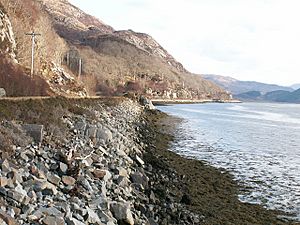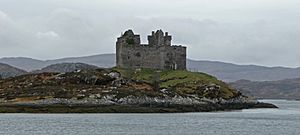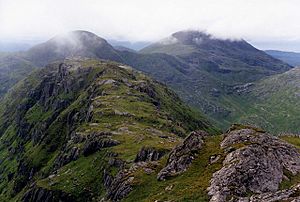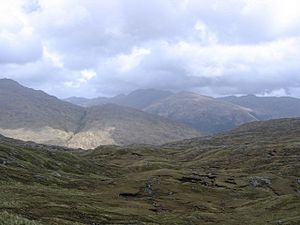Moidart facts for kids
Moidart (MOY-dart; Scottish Gaelic: Mùideart) is a beautiful and quiet area in the west of Scotland. It's located near Fort William and is part of a region called the Rough Bounds. Moidart is almost completely surrounded by water, which makes it feel like an island!
To the east, you'll find Loch Shiel. To the south, there's more of Loch Shiel and Loch Moidart. In the north, Loch Morar and Loch Ailort complete the watery border.
Today, Moidart is part of Lochaber in the Highland council area. It includes small communities like Dorlin, Kinlochmoidart, and Glenuig. At Dorlin, you can see Castle Tioram, an old castle that used to belong to important Scottish clans like the Clann Ruaidhrí and the Clanranald.
Moidart is also part of the Morar, Moidart and Ardnamurchan National Scenic Area. This is one of 40 special areas in Scotland. They are protected because of their amazing natural beauty. This helps make sure that the scenery stays wonderful for everyone to enjoy.
Contents
Moidart's Past: A Look at History
Early Days and Viking Influence
Long ago, Vikings came to Scotland. Moidart became part of the Kingdom of the Isles, which was controlled by Norway. This is how Moidart got its name! It comes from an old Norse word, mod, meaning mud, and -art, which means fjord (a long, narrow sea inlet). So, Moidart means muddy loch, referring to Loch Moidart.
Later, in the late 1000s, the Scottish King Malcolm III of Scotland and the Norwegian King Magnus Barelegs made a deal. The border moved, and Moidart became part of Scotland.
The Rise of Somerled and the MacRorys
In the early 1100s, a powerful leader named Somerled took control of Moidart and the areas around it. We don't know exactly how he did it, but he became very strong. He even joined his lands with the Kingdom of the Isles, creating a large, independent state.
After Somerled died, Norway took back some control. But his kingdom was split up. The part that included Moidart was called Garmoran. It was ruled by the MacRory family, who were part of Somerled's descendants.
Castle Tioram and Clan Changes
In 1266, the Treaty of Perth made Garmoran a Scottish area, but the MacRorys still ruled it. This area was known as the Lordship of Garmoran. Around this time, Castle Tioram was built on Loch Moidart. It became the main home for the Lords of Garmoran.
The rest of the Kingdom of the Isles became the Lordship of the Isles, ruled by the MacDonalds. The leader of the MacDonalds, John of Islay, married the last MacRory heir, Amy of Garmoran. They had three sons. But then John divorced Amy to marry the king's niece, which brought him a lot of money and power.
As part of this deal, John made sure his oldest son with Amy, Ranald, could not inherit the Lordship of the Isles. Instead, Ranald became the Lord of Garmoran.
Troubles and Royal Control
When Ranald died, his sons were still young. His younger brother, Godfrey, took over the Lordship of Garmoran. This led to a lot of fighting between Godfrey's family and Ranald's sons.
In 1427, King James I was tired of all the violence in the Highlands. He called a meeting in Inverness for all the powerful leaders. When they arrived, many were arrested. Alexander MacGorrie, Godfrey's son, was seen as one of the worst offenders. He was quickly put on trial and executed. Since Alexander had taken over as Lord of Garmoran, and Ranald's sons were also involved in the fighting, King James took away the Lordship of Garmoran completely.
New Owners and Clan Ranald
In 1469, King James III gave the lands of Garmoran and Uist to John, the Lord of the Isles. John then gave it to his half-brother, Hugh of Sleat. The king confirmed this in 1493. The fighting had almost wiped out Godfrey's family, and they no longer played a part in Moidart's history.
However, Ranald's descendants, the Clan Ranald, fought against this new ownership. After Hugh of Sleat died in 1498, his son gave all the land back to the king. In 1532, the king gave Moidart to the leader of Clan Ranald, a man known as John Moidartach.
Later, in 1609, John's grandson Donald was put in prison because of some lawlessness in the area. Donald was only set free if he promised to obey King James VI and his laws. In return, the king gave Donald a new document confirming his ownership of the lands.
Moidart in Later Years
The Rough Bounds area, including Moidart, was a strong supporter of the Jacobite cause. After the Jacobite rising of 1745 failed, Moidart was the last place in Scotland where Bonnie Prince Charlie found safety. He finally left Scotland from Loch nan Uamh. He took seven important men with him, who became known as the Seven Men of Moidart. A century later, a row of beech trees was planted to remember them.
Unlike many other areas, no military roads were built into Moidart. It remained without proper road access until the A861 was built in 1966. Before that, you could only get there by a rough footpath or a ferry between Lochailort and Glenuig. It wasn't until 1988 that people living in Moidart got electricity!
Because it was so remote, Moidart kept its strong Catholicism and the Gaelic language. Even in 1881, about 90% of people spoke Gaelic, and over a third couldn't speak English. By 2001, fewer than 15% spoke Gaelic.
The isolation of Moidart also made it a perfect place for training during World War II. Several secret training bases for special units were set up there. One base, HMS Dorlin, was used to train Royal Navy and Royal Signals groups.
Famous People from Moidart
- Alasdair mac Mhaighstir Alasdair, an 18th-century Gaelic poet and Jacobite supporter.
- Fergie MacDonald, a famous musician, grew up in this area.






